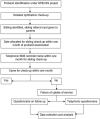Identification of potential barriers for timely access to pediatric sibling eye check-up in a tertiary eye care hospital
- PMID: 36588239
- PMCID: PMC10155517
- DOI: 10.4103/ijo.IJO_1739_22
Identification of potential barriers for timely access to pediatric sibling eye check-up in a tertiary eye care hospital
Abstract
Purpose: To identify socio-economic, demographic, and clinical factors that may be associated with sibling access to ophthalmic check-up.
Methods: A cross-sectional, descriptive study investigated children in the age group of 0-15 years under a project on Systematic Pediatric Eye Care Through Sibling Screening Strategies (SPECSSS project). The siblings of pediatric patients (proband) with refractive errors, strabismus, cataract, glaucoma, and retinal pathologies were given a referral card for ophthalmic check-up. If parents do not bring siblings for check-up within 1 month of initial information and even after 2 SMS reminders, it was considered as failure to uptake of services. On follow-up later, they were provided a questionnaire. A questionnaire was given to the parent by interview through a project coordinator, and details were obtained from the parents or caretaker. Parents who were willing for telephonic interview were asked to respond to the questionnaire over phone on the scheduled date. The sibling details, parent-related details, and data from questionnaire forms were entered and analyzed.
Results: The mean age of 300 siblings was 9.3 ± 4.0 years with the majority of them being female (158). The most common reasons quoted by parents in the rural area compared with the urban area for not bringing siblings for eye exams were the travel distance from home to the hospital (n = 118, 83.7%), the travel time from home to the hospital (n = 109, 77.3%), more than one vehicle required to change (n = 111, 78.7%), and the transportation cost more than rupees 100 (INR) (n = 89, 63.1%) (p < 0.05). Unable to leave work responsibilities (n = 126, 79.3%) was stated more frequently by urban parents compared to rural (p = 0.039).
Conclusion: Our study suggests that the financial factor, the distance factor, and social belief play an important role in timely uptake of sibling eye check-up. Targeting siblings with treatable pediatric eye diseases could help in reducing the burden of refractive error, strabismus, and cataract in the pediatric population.
Keywords: Barrier; pediatric; questionnaire; refractive error; sibling.
Conflict of interest statement
There are no conflicts of interest.
Figures
Comment on
-
Barriers and enablers to access childhood cataract services across India. A qualitative study using the Theoretical Domains Framework (TDF) of behaviour change.PLoS One. 2021 Dec 31;16(12):e0261308. doi: 10.1371/journal.pone.0261308. eCollection 2021. PLoS One. 2021. PMID: 34972107 Free PMC article.
Similar articles
-
Primary eye care in pediatric population-I study (PREPP-I study): Demographic and clinical profile of pediatric patients treated in six major vision centers of a tertiary eye care facility in South India.Indian J Ophthalmol. 2023 Feb;71(2):614-617. doi: 10.4103/ijo.IJO_1840_22. Indian J Ophthalmol. 2023. PMID: 36727372 Free PMC article.
-
Role of a Community-based Program for Identification and Referral of Pediatric Cataract Patients in Kinshasa, Democratic Republic of the Congo.Middle East Afr J Ophthalmol. 2019 Aug 26;26(2):83-88. doi: 10.4103/meajo.MEAJO_273_18. eCollection 2019 Apr-Jun. Middle East Afr J Ophthalmol. 2019. PMID: 31543665 Free PMC article.
-
Identifying barriers to referrals in preschool-age ocular screening in Southern India.Indian J Ophthalmol. 2020 Oct;68(10):2179-2184. doi: 10.4103/ijo.IJO_1603_19. Indian J Ophthalmol. 2020. PMID: 32971635 Free PMC article.
-
Spectrum of ophthalmic diseases in children hospitalized in a tertiary ophthalmology hospital in China from 2010 to 2019.BMC Ophthalmol. 2022 Jul 19;22(1):314. doi: 10.1186/s12886-022-02533-5. BMC Ophthalmol. 2022. PMID: 35854241 Free PMC article.
-
Ophthalmic manifestations of Smith-Magenis syndrome.Ophthalmology. 1996 Jul;103(7):1084-91. doi: 10.1016/s0161-6420(96)30563-0. Ophthalmology. 1996. PMID: 8684798 Review.
Cited by
-
EyeCNN: exploring the potential of convolutional neural networks for identification of multiple eye diseases through retinal imagery.Int Ophthalmol. 2023 Oct;43(10):3569-3586. doi: 10.1007/s10792-023-02764-5. Epub 2023 Jun 8. Int Ophthalmol. 2023. PMID: 37291412
References
-
- Williams C, Northstone K, Howard M, Harvey I, Harrad RA, Sparrow JM. Prevalence and risk factors for common vision problems in children:Data from the ALSPAC study. Br J Ophthalmol. 2008;92:959–64. - PubMed
-
- Majeed M, Williams C, Northstone K, Ben-Shlomo Y. Are there inequities in the utilisation of childhood eye-care services in relation to socio-economic status?Evidence from the ALSPAC cohort. Br J Ophthalmol. 2008;92:965–9. - PubMed
-
- Bandamwar K, Kanduri S, Siddireddy JS. Prevalence and patterns of refractive errors in children and young adults in an urban region in south India:The Hyderabad eye study. Ophthalmic Epidemiol. 2022 doi:10.1080/09286586.2022.2032202. - PubMed
-
- Fu Z, Hong H, Su Z, Lou B, Pan CW, Liu H. Global prevalence of amblyopia and disease burden projections through 2040:A systematic review and meta-analysis. Br J Ophthalmol. 2020;104:1164–70. - PubMed
Publication types
MeSH terms
LinkOut - more resources
Full Text Sources
Medical


